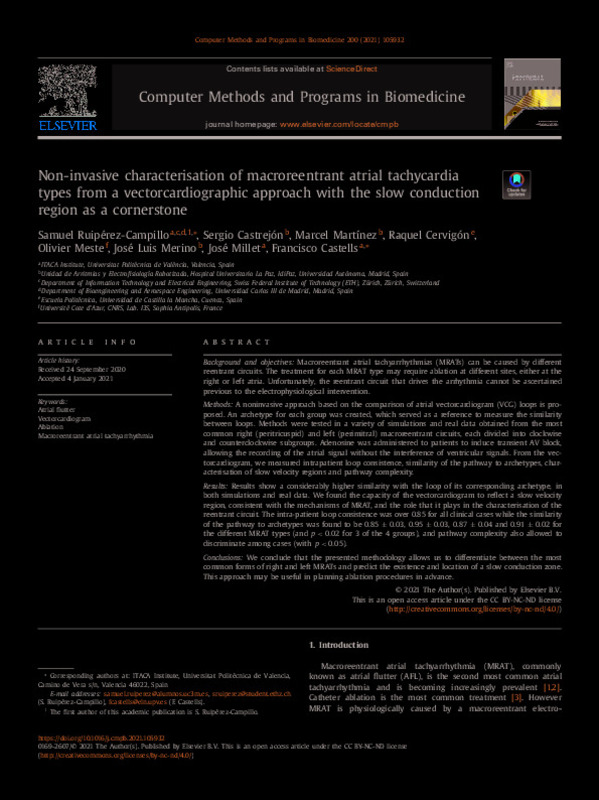JavaScript is disabled for your browser. Some features of this site may not work without it.
Buscar en RiuNet
Listar
Mi cuenta
Estadísticas
Ayuda RiuNet
Admin. UPV
Non-invasive characterisation of macroreentrant atrial tachycardia types from a vectorcardiographic approach with the slow conduction region as a cornerstone
Mostrar el registro sencillo del ítem
Ficheros en el ítem
| dc.contributor.author | Ruipérez-Campillo, Samuel
|
es_ES |
| dc.contributor.author | Castrejón, Sergio
|
es_ES |
| dc.contributor.author | Martínez, Marcel
|
es_ES |
| dc.contributor.author | Cervigón, Raquel
|
es_ES |
| dc.contributor.author | Meste, Olivier
|
es_ES |
| dc.contributor.author | Merino, José Luis
|
es_ES |
| dc.contributor.author | Millet Roig, José
|
es_ES |
| dc.contributor.author | Castells, Francisco
|
es_ES |
| dc.date.accessioned | 2022-07-08T18:04:53Z | |
| dc.date.available | 2022-07-08T18:04:53Z | |
| dc.date.issued | 2021-03 | es_ES |
| dc.identifier.issn | 0169-2607 | es_ES |
| dc.identifier.uri | http://hdl.handle.net/10251/183982 | |
| dc.description.abstract | [EN] Background and objectives: Macroreentrant atrial tachyarrhythmias (MRATs) can be caused by different reentrant circuits. The treatment for each MRAT type may require ablation at different sites, either at the right or left atria. Unfortunately, the reentrant circuit that drives the arrhythmia cannot be ascertained previous to the electrophysiological intervention. Methods: A noninvasive approach based on the comparison of atrial vectorcardiogram (VCG) loops is proposed. An archetype for each group was created, which served as a reference to measure the similarity between loops. Methods were tested in a variety of simulations and real data obtained from the most common right (peritricuspid) and left (perimitral) macroreentrant circuits, each divided into clockwise and counterclockwise subgroups. Adenosine was administered to patients to induce transient AV block, allowing the recording of the atrial signal without the interference of ventricular signals. From the vectorcardiogram, we measured intrapatient loop consistence, similarity of the pathway to archetypes, characterisation of slow velocity regions and pathway complexity. Results: Results show a considerably higher similarity with the loop of its corresponding archetype, in both simulations and real data. We found the capacity of the vectorcardiogram to reflect a slow velocity region, consistent with the mechanisms of MRAT, and the role that it plays in the characterisation of the reentrant circuit. The intra-patient loop consistence was over 0.85 for all clinical cases while the similarity of the pathway to archetypes was found to be 0.85 +/- 0.03, 0.95 +/- 0.03, 0.87 +/- 0.04 and 0.91 +/- 0.02 for the different MRAT types (and p < 0 . 02 for 3 of the 4 groups), and pathway complexity also allowed to discriminate among cases (with p < 0 . 05 ). Conclusions: We conclude that the presented methodology allows us to differentiate between the most common forms of right and left MRATs and predict the existence and location of a slow conduction zone. This approach may be useful in planning ablation procedures in advance. | es_ES |
| dc.description.sponsorship | This work was supported by PID2019-109547RB-I00 (National Research Program, Ministerio de Ciencia e Innovacion, Spanish Government), CIBERCV CB16/11/00486 (Instituto de Salud Carlos III) and PROMETEOII/2014/037 (Generalitat Valenciana). | es_ES |
| dc.language | Inglés | es_ES |
| dc.publisher | Elsevier | es_ES |
| dc.relation.ispartof | Computer Methods and Programs in Biomedicine | es_ES |
| dc.rights | Reconocimiento - No comercial - Sin obra derivada (by-nc-nd) | es_ES |
| dc.subject | Atrial flutter | es_ES |
| dc.subject | Vectorcardiogram | es_ES |
| dc.subject | Ablation | es_ES |
| dc.subject | Macroreentrant atrial tachyarrhythmia | es_ES |
| dc.subject.classification | TECNOLOGIA ELECTRONICA | es_ES |
| dc.title | Non-invasive characterisation of macroreentrant atrial tachycardia types from a vectorcardiographic approach with the slow conduction region as a cornerstone | es_ES |
| dc.type | Artículo | es_ES |
| dc.identifier.doi | 10.1016/j.cmpb.2021.105932 | es_ES |
| dc.relation.projectID | info:eu-repo/grantAgreement/AEI/Plan Estatal de Investigación Científica y Técnica y de Innovación 2017-2020/PID2019-109547RB-I00/ES/CUANTIFICACION DEL DETERIORO LOCAL DEL MIOCARDIO MEDIANTE CATETER MULTIELECTRODO GRID ALTA DENSIDAD. IDENTIFICACION DE METRICAS DEL SUSTRATO FIBROTICO RESPONSABLE DE ARRITMIAS/ | es_ES |
| dc.relation.projectID | info:eu-repo/grantAgreement/GVA//PROMETEOII%2F2014%2F037//ESTUDIO MEDIANTE TÉCNICAS CARTOGRÁFICAS AVANZADAS DE LOS MECANISMOS BÁSICOS IMPLICADOS EN LAS ARRITMIAS MALIGNAS Y EN SU CONTROL/ | es_ES |
| dc.relation.projectID | info:eu-repo/grantAgreement/MINECO//CB16%2F11%2F00486/ES/ENFERMEDADES CARDIOVASCULARES/ | es_ES |
| dc.rights.accessRights | Abierto | es_ES |
| dc.contributor.affiliation | Universitat Politècnica de València. Departamento de Ingeniería Electrónica - Departament d'Enginyeria Electrònica | es_ES |
| dc.description.bibliographicCitation | Ruipérez-Campillo, S.; Castrejón, S.; Martínez, M.; Cervigón, R.; Meste, O.; Merino, JL.; Millet Roig, J.... (2021). Non-invasive characterisation of macroreentrant atrial tachycardia types from a vectorcardiographic approach with the slow conduction region as a cornerstone. Computer Methods and Programs in Biomedicine. 200:1-15. https://doi.org/10.1016/j.cmpb.2021.105932 | es_ES |
| dc.description.accrualMethod | S | es_ES |
| dc.relation.publisherversion | https://doi.org/10.1016/j.cmpb.2021.105932 | es_ES |
| dc.description.upvformatpinicio | 1 | es_ES |
| dc.description.upvformatpfin | 15 | es_ES |
| dc.type.version | info:eu-repo/semantics/publishedVersion | es_ES |
| dc.description.volume | 200 | es_ES |
| dc.identifier.pmid | 33485078 | es_ES |
| dc.relation.pasarela | S\429345 | es_ES |
| dc.contributor.funder | Generalitat Valenciana | es_ES |
| dc.contributor.funder | AGENCIA ESTATAL DE INVESTIGACION | es_ES |
| dc.contributor.funder | Ministerio de Economía y Competitividad | es_ES |
| dc.subject.ods | 03.- Garantizar una vida saludable y promover el bienestar para todos y todas en todas las edades | es_ES |








